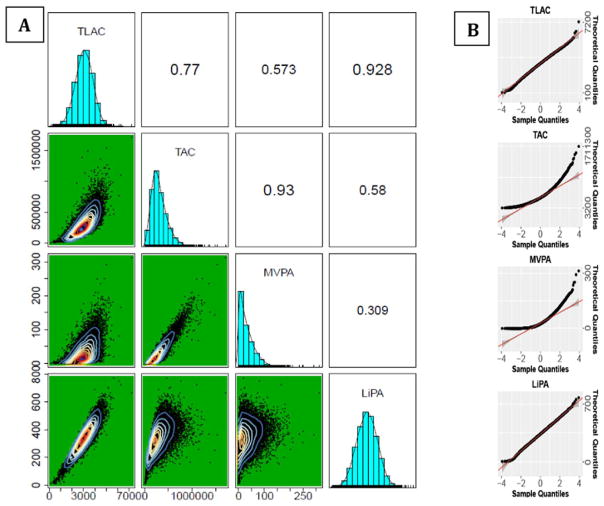1. Introduction
We thank Wolff-Hughes and colleagues for their thoughtful response (Wolff-Hughes et al., 2017) to our recently published findings (Varma et al., 2017). Wolff-Hughes et al. correctly indicate that our findings, which model physical activity (PA) over the lifespan using total log-transformed activity counts (TLAC) as a proxy measure for total volume of PA, are inconsistent with their findings (Wolff-Hughes et al., 2014; Wolff-Hughes et al., 2015) that use total (non-transformed) activity counts (TAC). The main issue is whether TLAC or TAC is the most appropriate measure of total volume of PA.
We argue that 1) TAC most closely reflects moderate-to-vigorous PA (MVPA) while TLAC most closely reflects light-intensity PA (LiPA); and propose 2) TAC(λ) as a unifying measure to appropriately capture total volume of PA.
2. Total volume vs. intensity
Total wake time (TWT) is the total amount of time spent in sedentary PA (SePA), LiPA, and MVPA. Normalized to TWT, the intensity specific times form a multivariate object that describes the composition (but not volume) of PA; this object belongs to an Aitchison simplex and demonstrates non-linear relationships with health outcomes (Chastin et al., 2015; Pedisic et al., 2017). An ideal measure of total volume of PA should reflect the full composition of PA and replicate corresponding non-linear effects on health outcomes. However, as indicated in Fig. 1.A, TAC generally reflects MVPA (correlation = 0.93) and TLAC generally reflects LiPA (correlation = 0.93). Thus, neither TAC nor TLAC can work as an aggregate measure across all intensity ranges. Additionally, as indicated in Fig. 1.B, the distributions of TAC and MVPA significantly deviate from normal distribution.
Fig. 1.
Correlations, distributions, and normality of TLAC, TAC, MVPA, and LiPA.
As indicated in prior publications using 2003–2006 NHANES accelerometer data, the median daily percent of minutes of MVPA and LiPA (assuming, on averaged, a 16 h TWT) among youth under the age of 19 is ~4% and 38% respectively (Wolff-Hughes et al., 2014), and among adults 20 and older the median percent is ~2% and 30% respectively (Wolff-Hughes et al., 2015). There is an approximate 10-fold difference in the median daily percent of MVPA compared to LiPA among youth and older adults, and the largest contributor to total PA is LiPA accumulated across the day. Our decision to use TLAC in our paper (Varma et al., 2017) was based partially on this observation. It is important to additionally note that our results showing trends in MVPA across the lifespan very closely match the results from Wolf-Hughes et al. showing TAC in youth (Wolff-Hughes et al., 2014) and adults (Wolff-Hughes et al., 2015) further indicating TAC may closely approximate MVPA however does not adequately model the contribution of lower intensity PA.
3. Unifying measure
The log-transformed minute-level activity counts (AC) used to generate TLAC is a special case of the Box-Cox transformed (Ravishanker and Dey, 2001) AC defined as AC(λ)=(ACλ−1)/λ. We define TAC(λ) as the total of Box-Cox transformed AC to get TAC(1)=TAC≈MVPA and TAC(0) =TLAC≈LiPA. TAC(λ) treated as a function of λ and analyzed as a functional data object using functional data analysis (Ramsay, 2006; Ramsay et al., 2009) may provide an opportunity to simultaneously model multiple intensities without using compositional data analysis and applying pre-defined intensity cut-points. Thus, working with TAC(λ), it may be possible to generate summaries that appropriately reflect the composition of PA and account for non-linear effects on health outcomes.
Our paper (Varma et al., 2017) explored total volume of PA across the lifespan using a summary measure that appropriately reflected LiPA, the major contributor to total accumulated PA across the day. We were able to identify age-related trends in PA and also show the importance of understanding how the allocation of PA across the day may drive those trends. We hope that future methods will continue to explore measures that do not require the use of pre-defined cut-points, and advance our ability to understand the complexity of PA across the day.
Acknowledgments
This work was supported by the National Institutes of Health (grants 5R01HL123407-02, 5R01AG049872-02, 5R01AG050507-02). VRV is supported by the Intramural Research Program, National Institute on Aging, NIH.
Footnotes
Conflicts of interest
None.
Transparency document
The http://dx.doi.org/10.1016/j.ypmed.2017.10.028 associated with this article can be found, in online version.
References
- Chastin SF, Palarea-Albaladejo J, Dontje ML, Skelton DA. Combined effects of time spent in physical activity, sedentary behaviors and sleep on obesity and cardio-metabolic health markers: a novel compositional data analysis approach. PLoS One. 2015;10(10):e0139984. doi: 10.1371/journal.pone.0139984. [DOI] [PMC free article] [PubMed] [Google Scholar]
- Pedisic Z, Dumuid D, Olds TS. Integrating sleep, sedentary behaviour, and physical activity research in the emerging field of time-use epidemiology: definitions, concepts, statistical methods, theoretical framework, and future directions. Kinesiology. 2017;49(2):10–11. [Google Scholar]
- Ramsay JO. Encyclopedia of Statistical Sciences. 4. John Wiley & Sons, Inc; 2006. Functional data analaysis. [Google Scholar]
- Ramsay JO, Hooker G, Graves S. Functional Data Analysis With R and MATLAB. Springer Science & Business Media; 2009. [Google Scholar]
- Ravishanker N, Dey DK. A First Course in Linear Model Theory. Chapman and Hall/CRC; 2001. [Google Scholar]
- Varma VR, Dey D, Leroux A, Di J, Urbanek J, Xiao L, et al. Re-evaluating the effect of age on physical activity over the lifespan. Prev Med. 2017 Aug;101:102–108. doi: 10.1016/j.ypmed.2017.05.030. [DOI] [PMC free article] [PubMed] [Google Scholar]
- Wolff-Hughes DL, Bassett DR, Fitzhugh EC. Population-referenced percentiles for waist-worn accelerometer-derived total activity counts in U.S. youth: 2003–2006 NHANES. PLoS One. 2014;9(12):e115915. doi: 10.1371/journal.pone.0115915. [DOI] [PMC free article] [PubMed] [Google Scholar]
- Wolff-Hughes DL, Fitzhugh EC, Bassett DR, Churilla JR. Waist-worn actigraphy: population-referenced percentiles for total activity counts in U.S. adults. J Phys Act Health. 2015 Apr;12(4):447–453. doi: 10.1123/jpah.2013-0464. [DOI] [PubMed] [Google Scholar]
- Wolff-Hughes DL, Bassett DR, White T. In response to: re-evaluating the effect of age on physical activity over the lifespan. Prev Med. 2017 doi: 10.1016/j.ypmed.2017.09.003. Accepted. [DOI] [PubMed] [Google Scholar]



